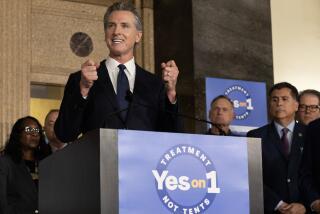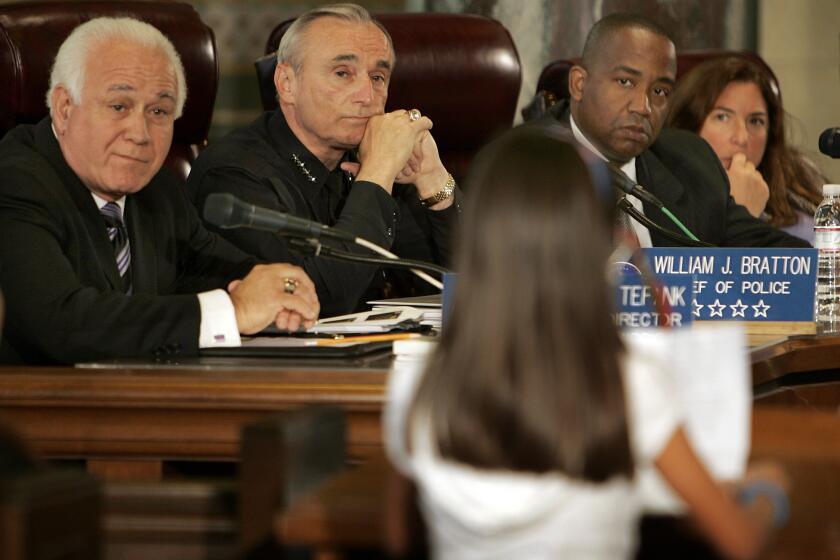Prop. 39 would end tax giveaway, raise $1 billion for California
SACRAMENTO — During the middle of a winter night in 2009, sleep-deprived legislators and Gov. Arnold Schwarzenegger devised the deal from hell. It included a tax incentive for out-of-state corporations not to build facilities or hire employees in California.
You read right. It was nonsensical.
The main feature of the agreement, you may recall, was a four-year tax increase. But the groggy legislators and governor foolishly gave voters an opportunity to halve the tax hike’s duration. And the voters eagerly did.
To soften the tax bite, voters also had to kill a rainy day reserve — a sort of spending cap — cherished by Schwarzenegger and Republicans, but despised by unions. So everyone in Sacramento lost in the special election: tax-seeking Democrats and unions; the spending-control-demanding GOP and governor.
But, to be truthful, the deal wasn’t all the work of the devil. As a price for the tax vote of then-Sen. Abel Maldonado (R-Santa Maria), a measure was placed on the 2010 ballot to dramatically change California’s election system, creating the “top two” open primary.
The new system may result in the election of some more pragmatic, centrist-leaning lawmakers.
Also surviving from that convoluted package, however, is the tax disincentive for out-of-state corporations to invest in California.
The purpose of Proposition 39 on the Nov. 6 ballot is to finally drive a stake through that monster giveaway, killing it and raising $1 billion.
Polling on Prop. 39 indicates weak voter support and general confusion.
A recent USC Dornsife/Los Angeles Times poll found a slim 51% majority of registered voters in favor, but only 29% against. A narrower Field Poll survey just of likely voters showed 45% in support, with 39% opposed.
Under Prop. 39, roughly half the new tax revenue would flow into the state’s general fund to help pay for services, including education. Kindergarten through community colleges would automatically receive at least $200 million annually.
The other half would be spent on stimulating the green economy. Specifically, it would pay for retrofitting public buildings, including schools and universities, with alternative energy equipment.
The energy spending would last five years. After that, the entire $1 billion would be poured into the general fund.
The driving force behind Prop. 39 is hedge-fund billionaire Thomas F. Steyer of San Francisco, a Democratic donor and environmentalist.
“Look, why would I get involved in arcane tax law?” Steyer asks rhetorically. “The truth is, this is obviously good for every Californian. It’s not going to raise a tax on any Californian.
“The state is not rich enough to throw away $1 billion a year.”
Right here I should try to explain the tax giveaway and Prop. 39’s solution.
Before the dead-of-night deal, corporate taxes were calculated on a formula that considered three factors: a company’s sales, workforce and property in California. Many companies had complained justifiably that this penalized job creation and facility building in California because expanding here would lead to higher taxes.
So legislators moved to adopt a “single sales factor,” as many other states had. Taxes would be based strictly on a company’s sales in California. But lobbyists for out-of-staters quickly flooded the Capitol corridors complaining about higher taxes for their clients.
The Legislature’s weak-kneed solution was to allow companies to choose whichever tax option best suited their bottom lines: the old formula or the new.
Prop. 39 would treat all corporations the same, basing a company’s tax solely on its in-state sales.
“We’re trying to close a tax loophole that advantages out-of-state companies at the expense of California citizens,” Steyer says.
Prop. 39 can be legitimately criticized for ungodly ballot-box budgeting, a California plague. All the new tax revenue should be poured into the general fund, helping to end deficit spending and balance the budget.
Steyer says he decided to use half the money for alternative energy because that would create thousands of jobs, “reduce our carbon footprint” and give voters an incentive to support the measure. They’d be reluctant, he figures correctly, to just turn all the money over to unpopular “Sacramento politicians.”
Anyway, the Legislature has failed three times to plug the loophole. Democrats couldn’t muster the handful of Republican votes needed for the required two-thirds majority.
Prop. 39 is what California’s initiative system is all about, empowering citizens to act when Sacramento refuses — assuming they can raise enough money. Steyer has pumped in nearly $22 million of his own wealth.
There is no funded opposition.
An out-of-state coalition of corporate heavy hitters, to use a baseball metaphor, backed off after Steyer threw a brushback pitch high, hard and inside.
Advised by veteran hardball strategist Chris Lehane, Steyer ran a threatening full-page newspaper ad featuring mug shots of “the big four tax dodgers” — the heads of General Motors, Kimberly-Clark, International Paper and Chrysler.
The CEOs retreated to the bench.
The California Chamber of Commerce opposes the measure, but quietly.
The chief opposition spokesman seems to be Jack Stewart, president of the California Manufacturers and Technology Assn.
“It’s a tax increase on some manufacturers here in California,” he says. “It’s a bad time to raise taxes on anyone.”
Stewart notes that these tax formulas are highly complex and not as simple as they seem to politicians and pundits.
True. But no one disputes that Prop. 39 would raise $1 billion for the state — money that could be put to better use than paying corporations not to invest in California.
More to Read
Start your day right
Sign up for Essential California for news, features and recommendations from the L.A. Times and beyond in your inbox six days a week.
You may occasionally receive promotional content from the Los Angeles Times.







